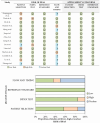The Role of Radiomics in the Prediction of Clinically Significant Prostate Cancer in the PI-RADS v2 and v2.1 Era: A Systematic Review
- PMID: 39272809
- PMCID: PMC11393977
- DOI: 10.3390/cancers16172951
The Role of Radiomics in the Prediction of Clinically Significant Prostate Cancer in the PI-RADS v2 and v2.1 Era: A Systematic Review
Abstract
Early detection of clinically significant prostate cancer (csPCa) has substantially improved with the latest PI-RADS versions. However, there is still an overdiagnosis of indolent lesions (iPCa), and radiomics has emerged as a potential solution. The aim of this systematic review is to evaluate the role of handcrafted and deep radiomics in differentiating lesions with csPCa from those with iPCa and benign lesions on prostate MRI assessed with PI-RADS v2 and/or 2.1. The literature search was conducted in PubMed, Cochrane, and Web of Science databases to select relevant studies. Quality assessment was carried out with Quality Assessment of Diagnostic Accuracy Studies 2 (QUADAS-2), Radiomic Quality Score (RQS), and Checklist for Artificial Intelligence in Medical Imaging (CLAIM) tools. A total of 14 studies were deemed as relevant from 411 publications. The results highlighted a good performance of handcrafted and deep radiomics methods for csPCa detection, but without significant differences compared to radiologists (PI-RADS) in the few studies in which it was assessed. Moreover, heterogeneity and restrictions were found in the studies and quality analysis, which might induce bias. Future studies should tackle these problems to encourage clinical applicability. Prospective studies and comparison with radiologists (PI-RADS) are needed to better understand its potential.
Keywords: PI-RADS; clinically significant prostate cancer; deep learning; machine learning; magnetic resonance imaging; prediction; radiomics; systematic review.
Conflict of interest statement
The authors declare no conflicts of interest.
Figures


References
-
- Epstein J.I., Egevad L., Amin M.B., Delahunt B., Srigley J.R., Humphrey P.A., Grading Committee The 2014 International Society of Urological Pathology (ISUP) Consensus Conference on Gleason Grading of Prostatic Carcinoma: Definition of Grading Patterns and Proposal for a New Grading System. Am. J. Surg. Pathol. 2016;40:244–252. doi: 10.1097/PAS.0000000000000530. - DOI - PubMed
Publication types
Grants and funding
LinkOut - more resources
Full Text Sources
Research Materials
Miscellaneous

